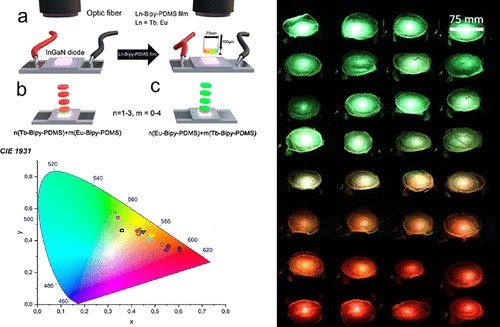by A. Miroshnichenko, K. Deriabin, A. Baranov, V. Neplokh, D. Mitin, I. Kolesnikov, M. Dobrynin, E. Parshina, I. Mukhin, R. Islamova
ACS Appl. Polym. Mater. 2022, 4, 4, 2683–2690
https://doi.org/10.1021/acsapm.2c00017

Light-excited flexible and self-healing luminescent polymers have attracted extensive attention for developing advanced color-emitting films. Luminophores on the base of lanthanide(III)-incorporating polysiloxanes exhibit a high photoresponse and can be applied for controlled color lighting in flexible device applications. We present red-, green-, and blue-emitting Eu3+, Tb3+, and Tm3+-bipyridinedicarboxamide-co-polydimethylsiloxanes (Ln-Bipy-PDMS) produced with a two-step procedure of polycondensation and complexation. Bipyridinic ligands provide formation of coordinatively saturated complexes of lanthanide ions and strong photoluminescence (PL) in the case of Eu3+ and Tb3+. The thin Ln-Bipy-PDMS films are studied as ultraviolet-light converters, which can be mechanically stacked one above another to achieve the desired color. We demonstrate that these stacks can have intense PL in the spectral range from green to yellow and red. Due to the structural features, Ln-Bipy-PDMS also demonstrate a relatively high tensile (approximately 1.5 MPa) and elongation at break (approximately 185%) and non-autonomous self-healing on heating. The self-healing properties of Ln-Bipy-PDMS enable the stacking of films into monoliths with the required color of PL. Such systems do not require any synthesis stages, and a one-healed monolith film possesses two luminescence colors.




